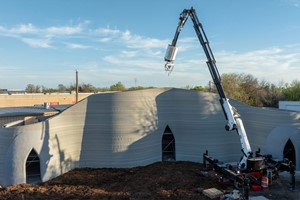The emergence and deployment of new technologies will be integral to meeting future sustainability ambitions. Katherine Bennett, Chief Executive at High Value Manufacturing Catapult (HVMC), explains.
The world is changing at an accelerated pace in both the natural and built environment. Historically, these two arenas have been at odds and seemingly in conflict. Increasingly, however, the world recognizes that we must bring them together in harmony to create a sustainable future.
The past 12 months was a year of change. In the unprecedented global pandemic that has ravaged economies all around the world, political leaders everywhere have recognized the need to double down on commitments to reduce carbon emissions and halt the future climate change catastrophe that threatens us all.
Late in 2021, the UK hosted the United Nations Climate Change Conference, known as COP26. The summit delivered the COP26 Glasgow climate pact, a significant step forward in global commitments to limit the impacts of global warming. Good news, but the scale of the transformation needed is considerable.
No sector, community or citizen will be untouched if we are to deliver on that pact. Just as science and rapid innovation is providing the pathway out of the pandemic, so a focus on technology can turn our climate goals from aspiration to reality. The first critical objective must be reaching net zero. To do that and create an environment in which our manufacturers can thrive, we need the technologies that will move us away from today’s reliance on fossil fuels and create the markets of the future.
The net zero opportunity
Developing a sustainable green energy economy is the bedrock of net zero. The UK needs a variety of sources of low carbon power. Nuclear is an obvious solution, but the sector has historically struggled with long lead times and financing challenges. Our Nuclear Advanced Manufacturing Research Centre (NAMRC) has shown we can reduce both cost and time by developing small, modular reactors.
Working as part of the Rolls-Royce led UK SMR Consortium, the center illustrated how an optimized machining strategy can reduce floorspace within the factories, while reducing production times through ideas such as advanced cleaning technologies. In November, the center hosted the launch of the new Rolls-Royce SMR business, which expects to create 40,000 jobs by the mid-2030s. Many of us might complain about the UK’s weather, but it is near-perfect for offshore wind. The UK currently has the world’s largest fleet of offshore turbines, supplying around 20% of our current electricity requirements.
The government has committed to increasing this seven-fold by 2050. Achieving this increase in energy output will push design, manufacturing and materials technology to the limits and composites will play a huge role in meeting those challenges. Our experts at the National Composites Centre have teamed up with the Offshore Renewable Energy Catapult to help develop the wind turbines of the future, propelling us to a cheaper, greener electricity grid.
Infrastructure and buildings account for around 20% of emissions. This presents something of a conundrum for industry and politicians, because we need to build 345,000 homes a year just to keep pace with demand.
But that’s also an opportunity and the HVM Catapult is making sure that we are ready to seize it. Our Advanced Manufacturing Research Centre has shown in its work with HLM Architects that the next generation of modular homes can be fully flexible and easily upgradeable. That means more sustainable materials than high emission cement, with homes upgraded as better materials become available.
The Construction Innovation Hub at our Manufacturing Technology Centre in Coventry is working to make sure that the UK has the capabilities needed to deliver a built environment that not only improves our quality of life, but also reduces environmental impact. ‘Electrification’ is a word that now drips freely from most politicians’ lips.
The ban on new petrol and diesel cars, which starts in 2030, means there are opportunities to reskill our mechanics and put an emphasis on overhauling the UK’s charging infrastructure. WMG, at the University of Warwick, is playing a key role in UK Research and Innovation’s ‘Driving the Electric Revolution Industrialization Centers’ program, leading a center in the Midlands that will build on the country’s capability in power electronics and electric machines.
The importance of hydrogen
Hydrogen is forecast to become a critical, balancing energy source, providing a viable route to decarbonise areas of industry and society that aren’t practical for electrification. Hydrogen is already replacing fossil fuels to decarbonise foundation industries (such as steel and glass), heating our homes and powering our cars.
Moreover, hydrogen is fuelling the lifeblood of the global economy, which is heavy goods transportation by HGVs on land, commercial shipping at sea, and planes in the air. The Committee for Climate Change’s Sixth Carbon budget and UK Hydrogen Strategy forecast that between 250-460 terawatt-hours of low carbon hydrogen will be required to reach net zero by 2050. That represents up to 35% of the UK’s energy consumption.
However, the UK currently does not have the capacity to produce large quantities of low carbon hydrogen and it is not ordinarily used as part of the energy mix today. This means that new technology and a huge amount of infrastructure will be required to achieve these targets in the UK alone.
Globally, the hydrogen economy is expected to reach $700bn by 2050, necessitating $11tn of investment in infrastructure. There is, then, a huge reliance on manufacturing technology to address key innovation challenges. For example, we must drive down the costs of the next generation of electrolysers that produce hydrogen.
Hydrogen-powered vehicles will need to be more efficient, reliable and safer if we are to see their widespread adoption. This challenge extends beyond manufacturing into infrastructure planning, the impact on the overall energy system, the deployment of infrastructure at scale, and the regulation and measurement of those technologies.













